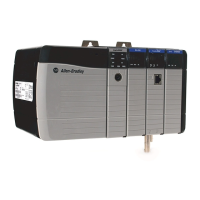Rockwell Automation Publication 1756-RM003N-EN-P - October 2011 59
FactoryTalk Alarms and Events Logix-based Instructions (ALMD, ALMA) Chapter 1
HHSeverity DINT Severity of the High High alarm condition. This does not affect processing of alarms by the controller, but
can be used for sorting and filtering functions at the alarm subscriber.
Valid = 1...1000 (1000 = most severe; 1 = least severe).
Default = 500.
HLimit REAL High alarm limit.
Valid = LLimit < HLimit < HHLimit.
Default = 0.0.
HSeverity DINT Severity of the High alarm condition. This does not affect processing of alarms by the controller, but can be
used for sorting and filtering functions at the alarm subscriber.
Valid = 1...1000 (1000 = most severe; 1 = least severe).
Default = 500.
LLimit REAL Low alarm limit.
Valid = LLLimit < LLimit < HLimit.
Default = 0.0.
LSeverity DINT Severity of the Low alarm condition. This does not affect processing of alarms by the controller, but can be
used for sorting and filtering functions at the alarm subscriber.
Valid = 1...1000 (1000 = most severe; 1 = least severe).
Default = 500.
LLLimit REAL Low Low alarm limit.
Valid = maximum negative float < LLLimit < LLimit.
Default = 0.0.
LLSeverity DINT Severity of the Low Low alarm condition. This does not affect processing of alarms by the controller, but
can be used for sorting and filtering functions at the alarm subscriber.
Valid = 1...1000 (1000 = most severe; 1 = least severe).
Default = 500.
MinDurationPRE DINT Minimum duration preset (milliseconds) for an alarm level condition to remain true before the condition is
marked as InAlarm and alarm notification is sent to clients. The controller collects alarm data as soon as
the alarm condition is detected, so no data is lost while waiting to meet the minimum duration. Does not
apply to rate-of-change conditions.
MinDurationPRE applies only to the first excursion from normal in either direction. For example, once the
High condition times out, the High High condition will become active immediately, while a low condition
will wait for the time-out period.
Valid = 0...2,147,483,647.
Default = 0.
Deadband REAL Deadband for detecting that High High, High, Low, and Low Low alarm levels have returned to normal.
A non-zero Deadband can reduce alarm condition chattering if the In value is continually changing but
remaining near the level condition threshold. The Deadband value does not affect the transition to the
InAlarm (active) state. Once a level condition is active, but before the condition will return to the inactive
(normal) state, the In value must either:
· drop below the threshold minus the deadband (for High and High High conditions).
· rise above the threshold plus the deadband (for Low and Low Low conditions).
The Deadband is not used to condition the Minimum Duration time measurement.
Valid = 0 ≤ Deadband < Span from first enabled low alarm to the first enabled high alarm.
Default = 0.0.
ROCPosLimit REAL Limit for an increasing rate-of-change in units per second. Detection is enabled for any value > 0.0 if
ROCPeriod is also > 0.0.
Valid = 0.0...maximum possible float.
Default = 0.0.
Input Parameter Data Type Description

